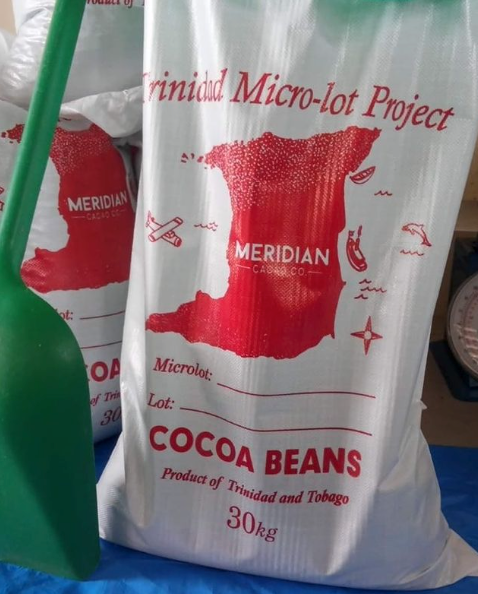
History of Cocoa in Trinidad
Share
Trinidad has a storied cocoa history and a great reputation for fine-flavored cacao. And while these days, most Trinidad beans get bulked into homogenized containers, there are many small-scale farmers in Trinidad doing amazing and unique things with their beans. Without technical support and market access, their lots still get combined with all the rest.
Since the 2016-17 harvest season in Trinidad, Sarah Bharath has led our Trinidad Microlot Program. Sarah is a cacao expert with more than 15 years of experience in cocoa genetics, agriculture, and processing. She has been on the ground daily with cacao farmers and fermentaries throughout the country, helping them process and select the best beans that they have.
Together with Sarah, Meridian compiles a container of cocoa beans from Trinidad that has microlots from individual farmers and regions, representing the best prepared cacao in the country. Some of the lots are as small as one bag, from an individual farmer. Each lot is a unique representation of the region from which it was grown; we are so proud to be able to offer these beans to our customers here in the US.
Below, Sarah gives us some insight on the history of cocoa in Trinidad based on historical information compiled and published in the works of Michael Anthony (Towns and Villages of Trinidad and Tobago) and Gérard Besson & Bridget Brereton (The Book of Trinidad).
---
Trinidad and Tobago is a twin island republic that lies at the southernmost end of the Caribbean chain, just northeast of Venezuela. Trinidad, a small island of 3180 square miles, was initially inhabited by the First Peoples (also known as Amerindians in early literature) comprising several tribes of whom the Caribs and Arawaks are the best known but by no means the only tribes at that time. Christopher Columbus came across Trinidad in his 1492 travels, claiming it immediately for Spain. Under Spanish rule many of Trinidad’s Amerindians died from new diseases introduced by the Spanish settlers. In order to encourage development of the lands in Trinidad, José de Galvez (the Spanish king’s representative in Trinidad) put forth the Cedula of Population in 1783, an edict that allowed immigration into Trinidad primarily from the neighbouring French Caribbean islands (Martinique and Guadeloupe). This marked the start of the plantation economy in Trinidad.
Trinidad’s first phase of rapid development was tied the expansion of sugar production, which lasted from the 1780’s to 1820’s. However, even by the 1830’s, Trinidad remained quite underdeveloped, with vast areas of fertile land still under forest cover. The second frontier started in 1870, and involved internal colonisation of the island, with many new settlements associated with cocoa plantations. The mass consumption of chocolate and cocoa beverages in Europe and North America increased the demand for cocoa, further fueling rapid expansion of cocoa production in Trinidad.
Around the early 1720s, Trinidad (and the wider cocoa-producing Caribbean region) suffered major losses of the original cacao types that were reportedly established by the Spanish when they began occupying the country. The scientific and general literature, for a long time, cited that this initial collapse of cacao cultivation was due to a ‘blast’ or ‘blight’ which some interpreted as a disease, others as a hurricane, and still others as some mysterious event that devastated the existing Criollo types. Ultimately, whatever the physical cause of the demise of Criollo-type cacao in Trinidad, the subsequent introduction of Forastero material from Venezuela created a situation in which it is widely believed that remnant Criollo trees hybridized with the new Forastero types, thereby creating the world-renowned Trinidad Trinitario cacao, with delicate flavour notes, generally strong and highly productive trees and good tolerance to pest and disease.
Beginning in the late 1800s, Trinidad’s cocoa production boomed, outstripping sugar to become the country’s leading agricultural export in a few short years. The land area under cacao cultivation expanded from 2400 hectares in 1856 to 90,000 hectares in 1917. Exports peaked in the mid-1920s and accounted for a fifth of global production.

However, over the course of the 1900s, the Trinidadian cocoa industry took huge hits which led to a near extinction of cocoa production on the island. Low world market prices and labor shortages led many plantation owners into bankruptcy. Also, the discovery of rich oil deposits dramatically shifted the country’s focus and worker supply into the oil industry. This continues even today and admittedly, because of continued government intervention since the late 1940s, Trinidad’s cocoa industry still exists - albeit in a considerably diminished form.
This research paper by Frances Bekele of the Cocoa Research Center at the University of the West Indies in Trinidad is a great resource for those interested in a more in-depth version of cocoa in Trinidad. It makes reference to the multiple rehab efforts over the years that have sputtered and chugged along but have never been truly successful at genuinely re-awakening the cocoa efforts. Until now. Today, growing local interest in the sector is fueled by the emergence of the artisan/craft chocolate industry, together with the increased awareness and interest of consumers in what they eat, how sustainably it is produced and a desire to encourage better relationships between producer and consumer.
--Sarah Bharath
